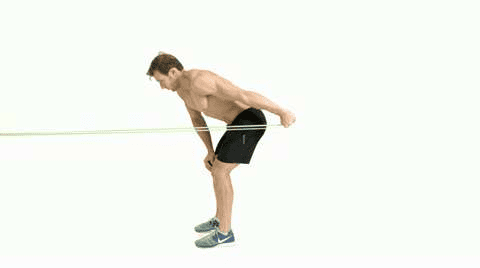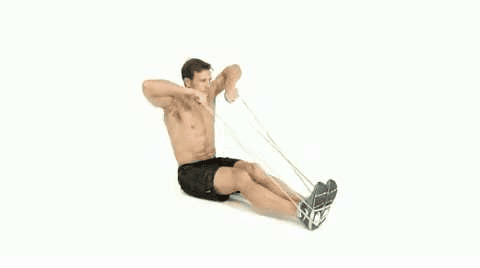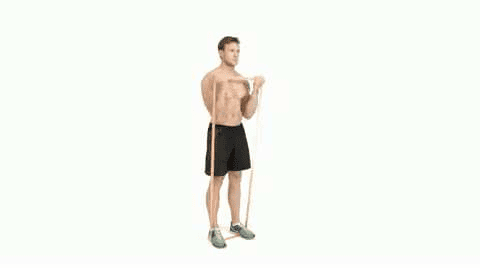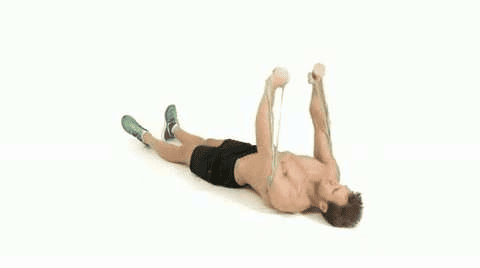resistance bands
Effective Resistance Band Exercises for Building Muscle and Strength
Looking to build muscle and strength without the hassle of heavy weights? Look no further than resistance bands! Known for their versatility, these bands can target different muscle groups, giving you a full-body workout. When purchasing resistance bands, make sure to choose ones with various strengths and options for height adjustment. For men, some key exercises include rowing, chest press, bicep curls, and squats with side lifts. The key to effectiveness lies in using proper form and avoiding common mistakes, such as using a band with too much tension or not securely attaching them. So get ready to take your workouts to the next level with these effective resistance band exercises! Resistance bands have become increasingly popular in the fitness world, and for good reason. These versatile exercise tools offer a wide range of benefits that make them a valuable addition to any workout routine. Whether you’re looking to build muscle and strength, incorporate variety into your exercises, or replace heavy weights, resistance bands have you covered. In this comprehensive article, we will explore the numerous benefits of resistance band exercises, how to choose the right bands for your needs, different exercises for each muscle group, proper form and technique, common mistakes to avoid, and even provide a sample resistance band workout to get you started. By the end, you will have all the tools and knowledge necessary to effectively incorporate resistance bands into your fitness routine.
Building muscle and strength
resistance bands offer a unique way to build muscle and strength without the need for heavy weights. The bands provide constant tension throughout the entire range of motion, which activates the muscles more effectively than traditional weights. This constant tension not only stimulates muscle growth but also helps to improve overall strength. Resistance band exercises engage multiple muscle groups simultaneously, providing a comprehensive full-body workout. Whether your goal is to increase muscle size, improve strength, or enhance athletic performance, resistance bands can be an excellent tool to help you reach your goals.
Versatility and variety
One of the biggest advantages of resistance bands is their versatility. These bands can be used for a wide variety of exercises, allowing you to target different muscle groups and work different parts of your body. From upper body exercises like rows and chest press to lower body exercises like squats and hip thrusts, the options are virtually endless. You can even use resistance bands for dynamic exercises like woodchops and shoulder presses to improve stability and coordination. The ability to easily switch between exercises and target specific areas of your body makes resistance bands a valuable tool for those looking to add variety to their workout routine.
Effective alternative to heavy weights
Resistance bands are a great alternative to heavy weights, especially for individuals who may have limitations or injuries that prevent them from lifting weights. These bands come in a range of strengths, allowing you to adjust the resistance to your individual needs. By using different bands with varying levels of resistance, you can effectively challenge your muscles and progressively overload them without putting excessive strain on your joints. This makes resistance band exercises a safe and effective option for individuals of all fitness levels, from beginners to advanced athletes.
Suitable for all fitness levels
Resistance bands are suitable for individuals of all fitness levels. Whether you’re a beginner who is just starting your fitness journey or an experienced athlete looking for a new challenge, resistance bands can be tailored to your specific needs. As mentioned earlier, the bands come in different strengths, allowing you to choose the level of resistance that suits your current fitness level. Additionally, resistance bands offer a low-impact workout option that is easier on the joints compared to heavy weights. This makes them ideal for individuals with joint issues or those who are recovering from an injury.
Convenience and portability
One of the major advantages of resistance bands is their convenience and portability. Unlike traditional weights, resistance bands are lightweight and compact, making them easy to store and transport. Whether you’re traveling, going to the gym, or simply working out at home, resistance bands can easily be packed in your bag or stored in a small space. This means you can get a full-body workout anytime, anywhere. Additionally, resistance bands require minimal setup and can be used in any space, whether it’s a small apartment or a crowded gym. With resistance bands, there are no excuses for not getting your workout in.
Choosing the Right Resistance Bands
Now that we understand the benefits of resistance bands, let’s discuss how to choose the right bands for your specific needs. When shopping for resistance bands, there are several factors to consider to ensure you select the best option for you.
Range of strengths
One important factor to consider is the range of strengths available in the resistance bands. Resistance bands typically come in various levels of resistance, ranging from light to heavy. It’s important to choose a set of bands that offers a wide range of strengths so that you can gradually progress and challenge your muscles as you get stronger. Having multiple bands with different resistance levels also allows you to target different muscle groups effectively.
Height adjustment options
Another important consideration when choosing resistance bands is the availability of height adjustment options. Some resistance bands come with attachments that allow you to adjust the height at which the bands are anchored. This is particularly useful for exercises that require the bands to be attached to a door frame or fixed object at a specific height. Being able to adjust the height gives you more flexibility in your workouts and ensures that you can perform exercises correctly and effectively.
Durable and high-quality materials
It’s essential to choose resistance bands that are made from durable and high-quality materials. Look for bands that are made from natural latex or high-quality synthetic materials, as these are more resistant to snapping or breaking during use. Additionally, bands with reinforced stitching and strong handles or grips are likely to last longer and provide a more comfortable experience.
Comfortable handles or grips
Comfort is a crucial factor when selecting resistance bands, especially when it comes to the handles or grips. Make sure that the bands you choose have comfortable handles or grips that are easy to hold and won’t cause discomfort or irritation during your workouts. Ergonomically designed handles or grips with a non-slip surface can significantly enhance your workout experience and allow you to maintain a secure grip throughout your exercises.
Suitable length for desired exercises
Finally, consider the length of the resistance bands and whether they are suitable for the exercises you plan to perform. Longer bands are generally more versatile, as they allow for a wider range of exercises and positions. However, shorter bands can be more practical for specific exercises that require limited range of motion. Consider your workout routine and choose bands that are long enough to accommodate your desired exercises while still allowing for proper form and technique.
Upper Body Resistance Band Exercises
Resistance bands can be used to target and strengthen various muscle groups in the upper body. Incorporating these exercises into your fitness routine can help you develop a well-rounded physique. Here are some effective upper body resistance band exercises to get you started:
Rowing
Rowing exercises with resistance bands target the muscles of the upper back, including the lats and rhomboids. To perform a rowing exercise, secure one end of the band to a stationary object at waist height. Hold the other end of the band with both hands, palms facing each other. With a slight bend in your knees and a straight back, pull the band towards your body, squeezing your shoulder blades together. Slowly return to the starting position and repeat for the desired number of repetitions.
Face pulls
Face pulls are an excellent exercise for targeting the rear deltoids and upper back muscles. To perform face pulls with resistance bands, attach the band to a stationary object at chest height. Grip the band with both hands, palms facing each other, and step back until there is tension in the band. Keeping your elbows high, pull the band towards your face, squeezing your shoulder blades together. Slowly return to the starting position and repeat.
Chest flyes
Chest flyes with resistance bands effectively target the chest muscles, specifically the pectoralis major. Secure the band to a stationary object at chest height and hold the band in each hand. Begin with your elbows slightly bent and arms out to the sides, parallel to the floor. Pull the band together in front of your chest, squeezing your pecs. Slowly return to the starting position and repeat.
Chest press
The chest press is another great exercise for targeting the chest muscles. Secure the resistance band to a stationary object at chest height and hold the handles in each hand. Position yourself with your back to the band and your arms bent at 90 degrees, palms facing forward. Press the handles straight out in front of you, extending your arms fully. Slowly return to the starting position and repeat.
Front raises
Front raises with resistance bands effectively target the front deltoids and upper chest muscles. Step on the band with one foot and hold the handles in each hand. Begin with your arms hanging down in front of your thighs, palms facing your body. Lift your arms out in front of you, keeping them straight, until they are parallel to the floor. Slowly lower your arms back down and repeat.
Bicep curls
Bicep curls with resistance bands are a classic exercise that targets the biceps muscles. Step on the band with one foot and hold the handles in each hand, palms facing forward. Keep your elbows close to your sides and curl your hands towards your shoulders, contracting your biceps. Slowly lower your hands back down and repeat.
Triceps kickbacks
Triceps kickbacks are an effective exercise for targeting the triceps muscles. Secure the band to a stationary object at waist height and hold the handles in each hand. Begin with your arms bent at 90 degrees, palms facing your body. Extend your arms straight back, contracting your triceps. Slowly return to the starting position and repeat.
Rotator cuff stretches
Resistance bands can also be used to stretch and strengthen the rotator cuff muscles. To perform rotator cuff stretches, attach the band to a stationary object at waist height. Hold the handle in one hand with your elbow bent at 90 degrees and your upper arm parallel to the floor. Keeping your elbow at your side, rotate your arm outward against the resistance of the band. Slowly return to the starting position and repeat.
Lower Body Resistance Band Exercises
In addition to targeting the upper body, resistance bands can be used to strengthen and tone the muscles of the lower body. Whether you’re looking to shape your glutes, strengthen your thighs, or improve your overall lower body strength, these exercises will help you achieve your goals:
Woodchops
Woodchops with resistance bands are a compound exercise that engages multiple muscle groups, including the core, obliques, and upper and lower body. To perform woodchops, secure the band to a stationary object above your head. Begin by holding the handle with both hands, standing with your feet shoulder-width apart. Start in a squat position with your arms down to one side of your body. As you rise from the squat, use your core and arms to swing the band diagonally across your body, finishing with your arms extended above your opposite shoulder. Slowly return to the starting position and repeat on the other side.
Shoulder presses
Shoulder presses performed with resistance bands target the deltoid muscles and can help improve overall shoulder strength. Step on the band with both feet and hold the handles at shoulder height, palms facing forward. Begin with your elbows bent at 90 degrees, and press the handles straight up overhead until your arms are fully extended. Slowly lower the handles back down to shoulder height and repeat.
Squats with side lifts
Squats with side lifts are a challenging exercise that targets the glutes, quadriceps, and outer thigh muscles. Stand on the band with both feet shoulder-width apart and hold the handles at your sides. Perform a squat by bending your knees and lowering your hips, keeping your chest up and your weight in your heels. As you stand back up, lift one leg out to the side, keeping the band taut. Return your leg to the starting position and repeat on the other side.
Resistance Band Exercises for Specific Muscle Groups
To maximize the benefits of resistance band exercises, it’s important to target specific muscle groups effectively. By focusing on different muscle groups, you can achieve a well-balanced and symmetrical physique. Here are some resistance band exercises categorized by specific muscle groups:
Chest and back
To target the chest and back muscles, incorporate exercises such as rowing, face pulls, chest flyes, and chest presses into your routine. These exercises effectively engage the muscles of the upper back, lats, and pectorals.
Arms and shoulders
For the arms and shoulders, exercises like bicep curls, triceps kickbacks, shoulder presses, and front raises can be highly effective. These exercises target the biceps, triceps, deltoids, and other muscles of the upper arms and shoulders.
Legs and glutes
To work the muscles of the legs and glutes, exercises like squats with side lifts, woodchops, and hip thrusts can be incorporated into your routine. These exercises engage the glutes, quadriceps, hamstrings, and other lower body muscles.
Core and abs
Engaging the core and abs is crucial for a strong and stable midsection. Incorporate exercises like woodchops, Russian twists, seated or standing rotations, and planks into your routine to effectively target the core muscles.
Full body
To get a complete full-body workout, incorporate exercises that engage multiple muscle groups simultaneously. Exercises like woodchops, squats with side lifts, and rows are great options for full-body activation and strengthening.
Proper Form and Technique
While resistance bands are a great addition to any fitness routine, it’s important to use proper form and technique to maximize their effectiveness and avoid injury. Here are some key tips for maintaining proper form and technique when performing resistance band exercises:
Maintaining proper posture
Proper posture is essential for performing resistance band exercises correctly. Keep your shoulders back and down, chest up, and spine neutral throughout each exercise. Avoid hunching or rounding your shoulders as this can put unnecessary strain on your upper back and neck.
Maintaining tension on the bands
To effectively engage your muscles, it’s important to maintain tension on the bands throughout the entire range of motion. Avoid letting the bands go slack or completely loose during exercises. By keeping tension on the bands, you ensure that your muscles are continuously engaged and working against resistance.
Using controlled and slow movements
Perform each resistance band exercise with controlled and slow movements. Avoid swinging or jerking the bands, as this can lead to poor form and potential injury. Slow and controlled movements allow you to maintain proper tension on the bands and effectively target the muscles.
Avoiding overstretching the bands
While resistance bands are designed to stretch, it’s important to avoid overstretching them. Overstretching can lead to loss of tension and potential snapping or breaking of the bands. Make sure to choose bands with an appropriate level of resistance for your strength level and avoid excessive stretching during exercises.
Breathing correctly
Proper breathing is often overlooked but plays a crucial role in maintaining proper form and technique during resistance band exercises. Inhale during the eccentric (lowering) phase of the exercise and exhale during the concentric (lifting) phase. Proper breathing helps stabilize your core and maintain proper tension throughout each movement.
Common Mistakes to Avoid
To ensure a safe and effective resistance band workout, it’s important to avoid common mistakes that can hinder your progress or lead to injury. Here are some common mistakes to avoid when using resistance bands:
Using a band with too much tension
Using a resistance band with too much tension can put excessive strain on your muscles and joints, leading to potential injury. Start with a lighter resistance band and gradually increase the tension as you get stronger. This gradual progression allows your muscles to adapt and helps prevent overexertion.
Incorrectly attaching the bands
Proper attachment of the bands is crucial for performing exercises safely and effectively. Make sure the bands are securely attached to a fixed object or anchored around your foot, depending on the exercise. Incorrect attachment can result in the band slipping or snapping during the movement.
Neglecting regular band replacements
Resistance bands can wear out over time, losing their elasticity and effectiveness. It’s important to regularly assess the condition of your bands and replace them as needed. Signs of wear include visible tears, fraying, or significant loss of elasticity. Regular band replacements will ensure a safe and efficient workout.
Improper warm-up and cool-down
Just like any other workout, it’s important to warm up your muscles before starting resistance band exercises and cool down afterward. Warming up helps increase blood flow to the muscles, preparing them for the workout ahead. Cooling down helps restore your heart rate and stretches the muscles to prevent stiffness and soreness.
Lack of variety in exercises
Adding variety to your resistance band workout is essential for targeting different muscle groups and preventing workout plateaus. Incorporate a wide range of exercises that target different muscle groups to achieve a well-rounded and balanced physique. This variety also helps keep your workouts interesting and enjoyable.
Sample Resistance Band Workout
To give you an idea of how to structure a resistance band workout, here is a sample workout that incorporates exercises for the upper body, lower body, and core:
Warm-up exercises
-
Arm circles: Stand with your feet shoulder-width apart and extend your arms out to the sides. Make small circles with your arms, gradually increasing the size of the circles. Complete 10 circles forward and 10 circles backward.
-
March in place: Stand tall with your feet hip-width apart. Lift your knees towards your chest, alternating legs in a marching motion. Perform this exercise for 1 minute.
Upper body circuit
Perform each exercise for 12-15 repetitions and complete 3 rounds.
-
Bicep curls: Stand on the band with both feet and hold the handles at your sides. Keep your elbows close to your sides and curl your hands towards your shoulders.
-
Chest press: Secure the band to a stationary object behind you and hold the handles at chest height. Press the handles straight out in front of you, extending your arms fully.
-
Triceps kickbacks: Attach the band to a stationary object at waist height. Hold the handles in each hand and extend your arms straight back, contracting your triceps.
Lower body circuit
Perform each exercise for 12-15 repetitions and complete 3 rounds.
-
Squats with side lifts: Stand on the band with both feet, holding the handles at your sides. Perform a squat, and as you stand back up, lift one leg out to the side while keeping the band taut. Return your leg to the starting position and repeat on the other side.
-
Woodchops: Attach the band to a stationary object above your head and hold the handles with both hands. Start in a squat position with your arms down to one side of your body. As you rise from the squat, use your core and arms to swing the band diagonally across your body, finishing with your arms extended above your opposite shoulder.
Core and abs routine
Perform each exercise for 12-15 repetitions and complete 3 rounds.
-
Russian twists: Sit on the floor with your knees bent and your feet lifted slightly off the ground. Hold the handles with both hands and twist your torso from side to side, keeping your core engaged.
-
Plank with band pull-aparts: Start in a plank position with the band securely wrapped around your hands. Keeping your core tight, pull the band apart by squeezing your shoulder blades together. Release and repeat.
Cool-down stretches
-
Standing quad stretch: Stand tall and hold onto a wall or rail for balance. Bend one knee and bring your heel towards your glutes. Hold for 20-30 seconds and repeat on the other side.
-
Seated hamstring stretch: Sit on the floor with your legs extended in front of you. Reach forward and try to touch your toes, feeling a stretch in the back of your legs. Hold for 20-30 seconds.
-
Child’s pose: Kneel on the floor and sit back on your heels. Extend your arms forward and lower your forehead to the ground, feeling a stretch in your back and shoulders. Hold for 20-30 seconds.
Tips for Progression and Maintenance
To continuously challenge yourself and make progress with resistance band exercises, follow these tips for progression and maintenance:
Gradually increasing resistance
As you get stronger, gradually increase the resistance of your bands. This can be done by either using a band with higher tension or by using multiple bands simultaneously. Increasing resistance ensures that your muscles continue to be challenged and stimulated for growth and strength gains.
Incorporating progressive overload
Progressive overload is an important principle in strength training. It involves gradually increasing the demands placed on your muscles over time to elicit continued improvements. With resistance bands, you can incorporate progressive overload by increasing the number of repetitions, sets, or the difficulty of the exercises. This could mean using a thicker or stronger band or adding additional resistance, like holding dumbbells or wearing ankle weights.
Regularly assessing and adjusting workout routine
To prevent plateauing and keep your workouts effective, it’s important to regularly assess and adjust your workout routine. This could mean changing the exercises, the order of exercises, or the resistance level of the bands. By keeping your body guessing, you prevent adaptation and continue to make progress towards your fitness goals.
Taking care of the bands
To ensure the longevity of your resistance bands, it’s important to take proper care of them. Keep them clean and dry after each use to prevent the buildup of sweat and bacteria. Store them in a cool, dry place away from direct sunlight, as exposure to heat can degrade the bands over time. Avoid using them on rough or abrasive surfaces that could cause damage.
Storing the bands properly
Proper storage of your resistance bands is crucial to prevent tangling or damage. Consider investing in a storage bag or container specifically designed for resistance bands. This will keep them organized and protected when not in use. Alternatively, you can loop the bands around a hook or peg to keep them neatly stored and easily accessible.
Conclusion
Resistance bands are an effective and versatile tool for muscle building and strength training. They provide numerous benefits, including building muscle and strength, offering variety in exercises, acting as an alternative to heavy weights, being suitable for all fitness levels, and offering convenience and portability. By choosing the right resistance bands, performing exercises correctly, avoiding common mistakes, and following proper form and technique, you can maximize the benefits of resistance band exercises. Remember to progress gradually, assess and adjust your routine regularly, and take care of your bands for continuous improvement. With resistance bands, you have a powerful tool for achieving your fitness goals and maintaining a strong and healthy body. So, grab your resistance bands and get started on this exciting fitness journey!





